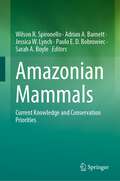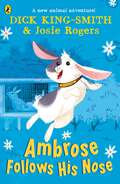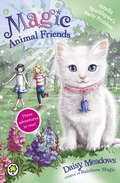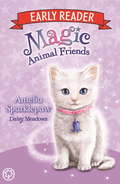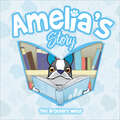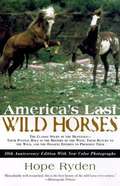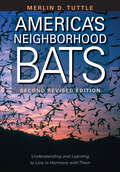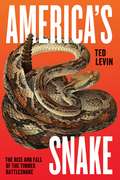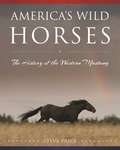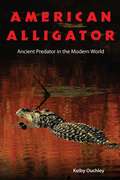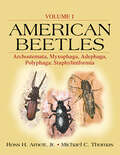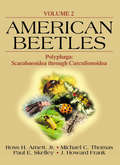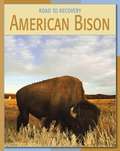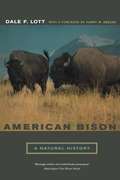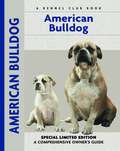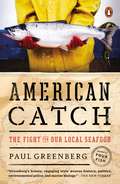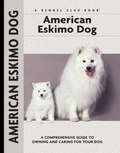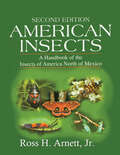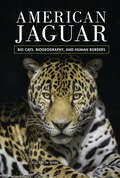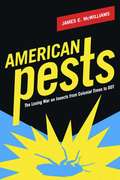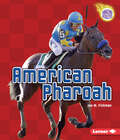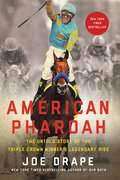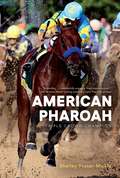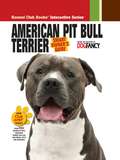- Table View
- List View
Amazonian Mammals: Current Knowledge and Conservation Priorities
by Adrian A. Barnett Wilson R. Spironello Jessica W. Lynch Paulo E. D. Bobrowiec Sarah A. BoyleThe mammal fauna of the Brazilian Amazon is one of the most diverse on Earth with over 450 known species. Bringing together more than 70 of the world’s top experts on Amazonian mammals, this book unites, for the first time, up-to-date data on the current state of knowledge on the ecology of all groups of non-rodent mammals in the Brazilian Amazon, analyses the effectiveness of current conservation programmes and identifies research and conservation priorities for the future.
Ambrose Follows His Nose
by Dick King-Smith Josie Rogers'Sparkling humour and wonderful characters are Dick King-Smith's trademarks' - Books for Your ChildrenAn exciting new publication in celebration of the centenary of his birth, a recently discovered funny and poignant animal story by Dick King-Smith, completed by his great granddaughter, Josie Rogers.Ambrose may seem like an ordinary rabbit but he has the most extraordinary sense of smell. He can detect any aroma from sweets to kittens - and even niffy foxes!He lives with his family in a hutch and is visited every day by Biddy, who is desperate to take him home to be her pet - if only her mum and dad would let her. Biddy trains Ambrose to become a tracker rabbit - which comes in very handy when Ambrose's little sister Roly goes missing. But when Biddy's family find themselves in real danger, can Ambrose's sensitive nose save the day?
Amelia Sparklepaw's Party Problem: Special 2 (Magic Animal Friends #2)
by Daisy MeadowsWelcome to a magical world where animals talk and play - just like you and me!In this BUMPER SPECIAL, Jess, Lily, and little kitten Amelia Sparklepaw are getting ready to celebrate Goldie's birthday - but wicked witch Grizelda has other plans! Can Lily, Jess and Amelia stop Grizelda and give Goldie the best birthday party ever?
Amelia Sparklepaw: Book 6 (Magic Animal Friends Early Reader #6)
by Daisy MeadowsThe much-loved series from the creator of Rainbow Magic - abridged for younger readers and illustrated in full colour!Welcome to a magical world where animals talk and play - just like you and me!Best friends Jess and Lily love all animals. But when they follow a mysterious golden cat into Friendship Forest - a place where animals live in tiny cottages and sip dandelion tea at the Toadstool Cafe - their animal friends suddenly become much more magical!Tiny kitten Amelia Sparklepaw is planning a party. Can the girls stop Grizelda the witch from ruining it?
Amelia's Story
by Jake Minor Matthew MinorAmelia is a curious Boston terrier who is always eager to learn new things. On a recent trip to the library she discovers the wonder of reading and the magic of books. This inspires her to take her own incredible idea and discover all the steps needed to make it into a book. But where to start? Join Amelia in her playful pursuit of knowledge as she learns all about how the pages of a story come to life. Includes nonfiction information on how to create a story map and make a book for enthusiastic young readers interested in writing.
America's Last Wild Horses
by Hope RydenFrom the Book Jacket: "A richly researched and written book with an unusual appeal." -Publishers Weekly "This book is a treat for everyone who knows or cares about horses." -Cleveland Amory No wild animal captures the spirit of North America quite so powerfully as the wild horse-nor has any faced such diverse and potent enemies. In this provocative account, Hope Ryden-who helped to ensure the passage of the Wild and Free-Roaming Horse and Burro Act, which grants mustangs special protection-combs the history of these proud and noble horses; Descended from the Spanish horses ridden by the conquistadors, they evolved into the tough and intelligent ponies that Indians-and later, explorers and cowboys-learned to rely on. From the period when wholesale extermination of the buffalo was underway until recent times, commercial and political interests have sought to eliminate the wild horses as varmints. In the latest update to this classic story Ryden tells of the successes: and failures in the past ten years of regulation, and has added stunning new color photographs. The subject of a front-page article in The New York Times. when it was first published, america's last wild horses continues to be a compelling testament to the life of a uniquely American symbol of grace and wildness, and is a must read for horse lovers and Western history enthusiast everywhere.
America's Neighborhood Bats: Understanding and Learning to Live in Harmony with Them (Revised Edition)
by Merlin D. TuttleSince its first publication in 1988, America's Neighborhood Bats has changed the way we look at bats by underscoring their harmless and beneficial nature. In this second revised edition, Merlin Tuttle offers bat aficionados the most up-to-date bat facts, including a wealth of new information on bat house design and current threats to bat survival.
America's Neighborhood Bats: Understanding and Learning to Live in Harmony with Them (Revised Edition)
by Merlin D. TuttleA guide to these frequently misunderstood animals that dispels unnecessary fears and encourages an appreciation of bats and their conservation needs. Since its publication in 1988, America&’s Neighborhood Bats has changed the way we look at bats by underscoring their harmless and beneficial nature. In this revised edition, Merlin Tuttle offers bat aficionados the most up-to-date bat facts, including a wealth of new information on attracting bats and building bat houses and a revamped key to the identification of common North American species. The easy-to-understand text, clear illustrations, and spectacular color photographs make this the perfect bat book for the general reader, as well as an invaluable resource for professionals who field questions from the public. Those who provide advice at health and animal control departments, museums, zoos, and nature centers will find it especially useful.
America's Snake: The Rise and Fall of the Timber Rattlesnake
by Ted LevinThere's no sound quite like it, or as viscerally terrifying: the ominous rattle of the timber rattlesnake. It's a chilling shorthand for imminent danger, and a reminder of the countless ways that nature can suddenly snuff us out. Yet most of us have never seen a timber rattler. Though they're found in thirty-one states, and near many major cities, in contemporary America timber rattlesnakes are creatures mostly of imagination and innate fear. Ted Levin aims to change that with America's Snake, a portrait of the timber rattlesnake, its place in America's pantheon of creatures and in our own frontier history--and of the heroic efforts to protect it against habitat loss, climate change, and the human tendency to kill what we fear. Taking us from labs where the secrets of the snake's evolutionary history are being unlocked to far-flung habitats whose locations are fiercely protected by biologists and dedicated amateur herpetologists alike, Levin paints a picture of a fascinating creature: peaceable, social, long-lived, and, despite our phobias, not inclined to bite. The timber rattler emerges here as emblematic of America and also, unfortunately, of the complicated, painful struggles involved in protecting and preserving the natural world. A wonderful mix of natural history, travel writing, and exemplary journalism, America's Snake is loaded with remarkable characters--none more so than the snake at its heart: frightening, perhaps; endangered, certainly; and unquestionably unforgettable.
America's Wild Horses: The History of the Western Mustang
by Steve PriceThere is no creature that quite embodies the beauty and grandeur of the American West as does the wild horse. For thousands of years, the horse has roamed the plains and valleys of the American continent, free of the encumbrances of man or the saddle. In America’s Wild Horses, award-winning photographer and lifelong horse lover Steven Price celebrates the timeless magnificence of the American mustang.Meticulously researched, Price offers a cultural history of the American wild horse that is unparalleled in its exquisite detail and poignant prose. Beginning with chapters on prehistoric equines, Price sweeps through all the most important historical epochs in the history of the American mustang. Detailed accounts of horse-breeding in the Southwest, Native American horsemanship, and mustangs in the golden age of the iconic American cowboys each detail the profound impact that the wild horse has had in shaping American culture. Later chapters chronicle the legacy of the horse in the twentieth and twenty-first centuries, specifically emphasizing the legal and scientific measures that are being taken by horse-lovers across the country to ensure that later generations will also be able to witness the majesty of the wild horse.Featuring dozens of stunning photographs by the author, and interspersed with firsthand interviews with some of the most renowned horse experts today, America’s Wild Horses is a required read for all equine lovers.
American Alligator: Ancient Predator in the Modern World
by Kelby OuchleyHaving survived since the Mesozoic era, alligators teetered on the brink of extinction in the 1960s. Their recovery in the 1970s was largely due to legislative intervention, and today populations are closely monitored throughout their range. American Alligator is the most up-to-date and comprehensive treatment of this resilient relic, a creature with a brain weighing less than half an ounce that has successfully adapted to a changing Earth for more than 200 million years.Kelby Ouchley chronicles the evolution of A. mississippiensis from "shieldcroc"--the last common ancestor of modern-day alligators, crocodiles, caimans, and gavials--to its current role as keystone of the ecological health of America's southern swamps and marshes. In Florida, the apex predator uses its snout and feet to clear muck from holes in the limestone bedrock. During the dry season, these small ponds or "alligator holes" provide refuge, food, and water for a variety of wildlife. In Louisiana, millions of dollars are spent on the bounty of the non-native nutria that overgraze marsh vegetation, but alligators prey on these coastal rodents free of charge.The loss of the American alligator would be a blow to biodiversity and an ecosystem disruption affecting all levels of the food chain. While the U.S. Fish and Wildlife Service removed it from the endangered species list in 1987 and today regulates the legal trade of the animal and its products, Ouchley cautions us not to forget the lessons learned: human activities, from urban development to energy production, can still threaten the future of the gator and its southern wetland habitat.
American Beetles, Volume I: Archostemata, Myxophaga, Adephaga, Polyphaga: Staphyliniformia
by Jr. Ross H. Arnett Michael C. ThomasA thorough update of Arnett's The Beetles of the United States, American Beetles, Volumes I and II cover the genera of beetles that occur in Alaska, Canada, and the contiguous United States. Built on the foundation of the original work and almost completely rewritten with contributions from more than 60 coleopterists, these volumes describe each fa
American Beetles, Volume II: Polyphaga: Scarabaeoidea through Curculionoidea
by J. Howard Frank Ross H. Arnett Michael C. Thomas Paul E. SkelleyExperts offer the most sweeping reference available on the subject of North American beetles. Their rigorous standards for the presentation of data create a concise, useful format that is consistent throughout the book. This is the resource of choice for quick, accurate, and easily accessible information.
American Bison (Road to Recovery)
by Barbara A. SomervillThe American bison was hunted to near extinction in the 1800s as settlers moved west across what is now the United States. Readers will learn about this animal that is a symbol of the American West and find out what steps were taken to help increase the American bison population.
American Bison: A Natural History
by Dale F. LottThis book, sixth in the series of 'Organisms and environments', presents a peek at the rich and unique ways of life that evolved in the heart of America and dismantles many of the myths about these ways of life, and about the bison in particular, to reveal the animal itself: ruminating, reproducing, and rutting in its full glory. He portrays the bison with an element of appeal to conserve its wildness and consider the importance of the wild in our lives. A beautifully written book by a recognized expert on one of the great icons of the American West.
American Bulldog
by Wil Deveer Abe FishmanOnce a well-kept secret in the United States, the American Bulldog is now one of the nation's most celebrated canine exports, establishing a devoted following around the globe. This Comprehensive Owner's Guide is dedicated to the American Bulldog, a breed that was once used as a ranch and farm dog but today excels as a companion and protection dog. Author Abe Fishman provides a controversial but wholly candid retelling of the breed's history and its re-creation in the United States. The history chapter is followed by a chapter devoted to the characteristics of this exceptional working breed, offering sound advice about which owners are best suited to this vigorous and active canine.New owners will welcome the well-prepared chapter on finding a reputable breeder and selecting a healthy, sound puppy. Chapters on puppy-proofing the home and yard, purchasing the right supplies for the puppy as well as house-training, feeding, and grooming are illustrated with photographs of handsome adults and puppies. In all, there are over 135 full-color photographs in this useful and reliable volume. The author's advice on obedience training will help the reader better mold and train into the most well-mannered dog in the neighborhood. The extensive and lavishly illustrated chapter on healthcare provides up-to-date detailed information on selecting a qualified veterinarian, vaccinations, preventing and dealing with parasites, infectious diseases, and more. Sidebars throughout the text offer helpful hints, covering topics as diverse as historical dogs, breeders, or kennels, toxic plants, first aid, crate training, carsickness, fussy eaters, and parasite control. Fully indexed. .
American Catch
by Paul GreenbergINVESTIGATIVE REPORTERS & EDITORS Book Award, Finalist 2014 <P><P>In American Catch, award-winning author Paul Greenberg takes the same skills that won him acclaim in Four Fish to uncover the tragic unraveling of the nation's seafood supply--telling the surprising story of why Americans stopped eating from their own waters. In 2005, the United States imported five billion pounds of seafood, nearly double what we imported twenty years earlier. Bizarrely, during that same period, our seafood exports quadrupled. <P><P>American Catch examines New York oysters, Gulf shrimp, and Alaskan salmon to reveal how it came to be that 91 percent of the seafood Americans eat is foreign. In the 1920s, the average New Yorker ate six hundred local oysters a year. Today, the only edible oysters lie outside city limits. Following the trail of environmental desecration, Greenberg comes to view the New York City oyster as a reminder of what is lost when local waters are not valued as a food source. Farther south, a different catastrophe threatens another seafood-rich environment. <P><P>When Greenberg visits the Gulf of Mexico, he arrives expecting to learn of the Deepwater Horizon oil spill's lingering effects on shrimpers, but instead finds that the more immediate threat to business comes from overseas. Asian-farmed shrimp--cheap, abundant, and a perfect vehicle for the frying and sauces Americans love--have flooded the American market. Finally, Greenberg visits Bristol Bay, Alaska, home to the biggest wild sockeye salmon run left in the world. A pristine, productive fishery, Bristol Bay is now at great risk: The proposed Pebble Mine project could under¬mine the very spawning grounds that make this great run possible. In his search to discover why this precious renewable resource isn't better protected, Green¬berg encounters a shocking truth: the great majority of Alaskan salmon is sent out of the country, much of it to Asia. Sockeye salmon is one of the most nutritionally dense animal proteins on the planet, yet Americans are shipping it abroad. <P><P>Despite the challenges, hope abounds. In New York, Greenberg connects an oyster restoration project with a vision for how the bivalves might save the city from rising tides. In the Gulf, shrimpers band together to offer local catch direct to consumers. And in Bristol Bay, fishermen, environmentalists, and local Alaskans gather to roadblock Pebble Mine. With American Catch, Paul Greenberg proposes a way to break the current destructive patterns of consumption and return American catch back to American eaters.
American Eskimo Dog
by Richard G. BeauchampThe magnificent snow-white coated American Eskimo Dog is the focus of this Comprehensive Owner's Guide, a book that celebrates the appealing personality, unmistakable intelligence, and captivating beauty of this made-in-America spitz breed. Serving as a complete introduction to the breed, long recognized by the United Kennel Club and more recently by the American Kennel Club, this book discusses the breed's evolution in the United States, the special characteristics of the breed, and both the AKC and UKC breed standards.New owners will welcome the well-prepared chapter on finding a breeder and selecting a healthy, sound puppy. Chapters on puppy-proofing the home and yard, purchasing the right supplies for the puppy as well as house-training, feeding, and grooming are illustrated with handsome adults and puppies bursting with attitude and personality! In all, there are over 135 photographs in this compact, useful, and reliable volume. The author's advice on obedience training the smart (but not too eager to please) American Eskimo will help readers better mold and train their dogs into the most socialized, well-mannered Eskie in the neighborhood. The extensive chapter on healthcare provides up-to-date detailed information on selecting a qualified veterinarian, vaccinations, parasites, infectious diseases, and more. Chapters on showing and participating in dog sports as well as solving common behavior issues (such as barking, aggression, digging, etc.) will prove informative and helpful to the new owner. Sidebars throughout the text offer helpful hints, covering topics as diverse as historical kennels, toxic plants, first aid, crate training, carsickness, fussy eaters, and parasite control. Fully indexed.
American Insects: A Handbook of the Insects of America North of Mexico, Second Edition
by Ross H. Arnett Jr.Offering a complete accounting of the insects of North America, this handbook is an up-dated edition of the first handbook ever compiled in the history of American entomology.By using American Insects, A Handbook of the Insects of America North of Mexico, Second Edition, readers can quickly determine the taxonomic position of any species, genus, or
American Jaguar: Big Cats, Biogeography, and Human Borders
by Elizabeth WebbIn the borderlands between the United States and Mexico, America's largest cat—the jaguar—is fighting to regain its kingdom. Added to the endangered species list in 1997, the jaguar has declined in population mainly due to habitat fragmentation created by roads, farms, mines, and most controversially, the border wall. Such human-made barriers prevent free movement of many wild animals for predation and mating, thereby threatening their reproduction, DNA transfer, and overall survival. Author and wildlife biologist Elizabeth Webb examines the jaguar's predicament and highlights the work of field scientists who are searching for solutions. "Conservation Connection" features throughout the book underscore the importance of protecting this keystone species of the Americas.
American Pests: The Losing War on Insects from Colonial Times to DDT
by James McWilliamsThe world of insects is one we only dimly understand. Yet from using arsenic, cobalt, and quicksilver to kill household infiltrators to employing the sophisticated tools of the Orkin Man, Americans have fought to eradicate the "bugs" they have learned to hate. Inspired by the still-revolutionary theories of Rachel Carson's Silent Spring, James E. McWilliams argues for a more harmonious and rational approach to our relationship with insects, one that does not harm our environment and, consequently, ourselves along the way. <P><P>Beginning with the early techniques of colonial farmers and ending with the modern use of chemical insecticides, McWilliams deftly shows how America's war on insects mirrors its continual struggle with nature, economic development, technology, and federal regulation. He reveals a very American paradox: the men and women who settled and developed this country sought to control the environment and achieve certain economic goals; yet their methods of agricultural expansion undermined their efforts and linked them even closer to the inexorable realities of the insect world. As told from the perspective of the often flamboyant actors in the battle against insects, American Pests is a fascinating investigation into the attitudes, policies, and practices that continue to influence our behavior toward insects. Asking us to question, if not abandon, our reckless (and sometimes futile) attempts at insect control, McWilliams convincingly argues that insects, like people, have an inherent right to exist and that in our attempt to rid ourselves of insects, we compromise the balance of nature.
American Pharoah (Amazing Athletes Ser.)
by Jon M FishmanIn 2015, racehorse American Pharoah won the Kentucky Derby, the Preakness Stakes, and finally the Belmont Stakes to become the first Triple Crown winner since 1978. The three-year-old horse with the misspelled name thrilled racing fans with his powerful and graceful running. As the 12th Triple Crown winner in history and the first in 37 years, American Pharoah joined an elite group of champions. Read all about the life of a legendary racehorse.
American Pharoah: The Untold Story of the Triple Crown Winner's Legendary Rise
by Joe DrapeHistory was made at the 2015 Belmont Stakes when American Pharoah won the Triple Crown, the first since Affirmed in 1978. As magnificent as the champion is, the team behind him has been all too human while on the road to immortality.Written by an award-winning New York Times sportswriter, American Pharoah is the definitive account not only of how the ethereal colt won the Kentucky Derby, Preakness, and Belmont Stakes, but how he changed lives. Through extensive interviews, Drape explores the making of an exceptional racehorse, chronicling key events en route to history. Covering everything from the flamboyant owner's successful track record, the jockey's earlier heartbreaking losses, and the Hall of Fame trainer's intensity, Drape paints a stirring portrait of a horse for the ages and the people around him.
American Pharoah: Triple Crown Champion
by Shelley Fraser MickleFrom the author of Barbaro comes the triumphant story of the 2015 Triple Crown and Breeders Cup winner, American Pharoah.When American Pharoah won the American Triple Crown and the Breeders’ Cup Classic in 2015 he became the first horse to win the “Grand Slam” of American horse racing, by winning all four races. His story captured American’s imagination, and this inspired account will also feature the handlers who saw his promise: owner, Ahmed Zayat of Zayat Stables, trainer Bob Baffert, and jockey Victor Espinoza. With American Pharoah, Shelley Mickle tells the story of this beloved horse’s life from birth to his historic achievement of becoming the twelfth Triple Crown winner.
American Pit Bull Terrier
by Dog Fancy MagazineSmart Owners Guide: American Pit Bull Terrier is the first interactive breed book of it kind to offer new and novice owners a fun new way to learn about caring for their loyal companions. American Pit Bull Terrier offers the most up-to-date online support with instant access to Club Club APBTTM where owners can meet and interact with other dedicated Pit owners, download charts and checklists, play Pit-specific games, take quizzes, and send themed e-cards. The book contains easy-to-read, informative content, with addition smart tips, notable quotations, fun facts, and more than 100 adorable breed photos that keep you flipping through the pages.
